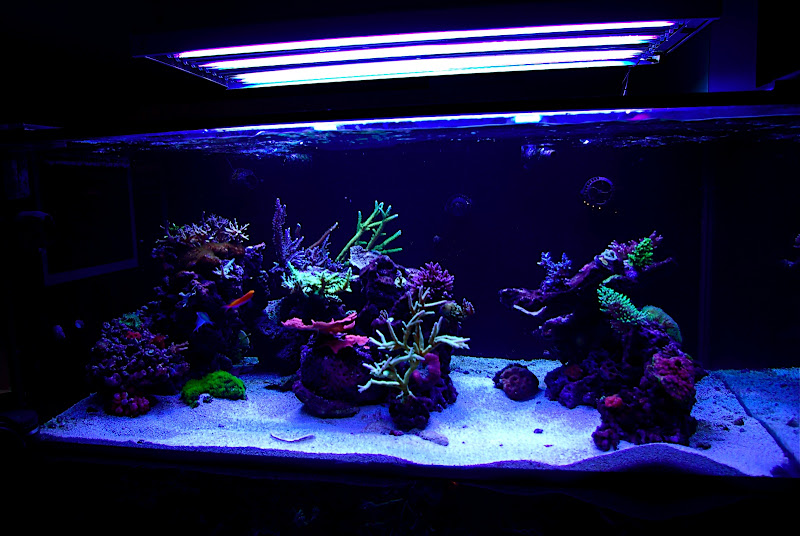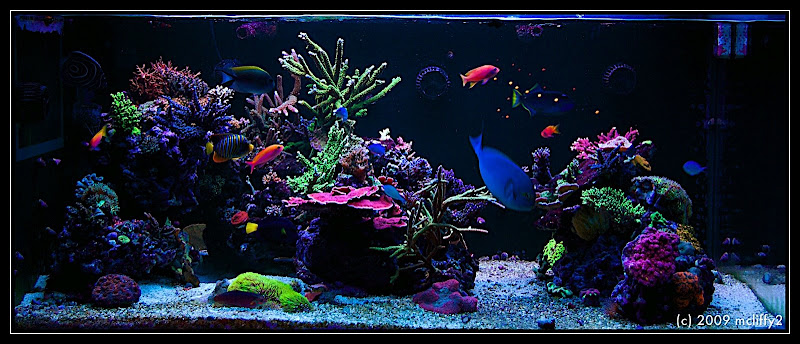mcliffy2
New member
Success with "living with" AEFW - potential predator or different variety of AEFW?
An initial disclaimer: please do not turn this into a debate over the merits of trading from an AEFW tank (I think we can all agree that disclosure is a must). I want to focus on what allows some to succeed and have a beautiful, thriving tank by just basting (or even just letting the AEFW go), and see if some trends can be identified, since IME, having AEFW has not been a big deal (see the before and after shots below).
The reports on "living with" AEFW (i.e. just basting them off periodically) seem to vary drastically. Some report that they have completely eradicated them by basting (ReefBum's gorgeous TOTM comes to mind), while others report that they are able to keep them in check enough that their system still thrives (I fall in this category), while others report that even with basting the problem got out of control and acros were being killed off.
Now having been someone who has "lived" with AEFW for almost a year, I think its safe to say, in at least some cases, you can be successful despite having AEFW in your system. Seeing the variations in success using basting, however, I think there may be more at play than just basting. I have two theories personally, as to why AEFW have not been a big deal in my tank:
1. Potential AEFW Predator -- I have a Christmas wrasse that I believe may keep AEFW in check, keeping their population to a low enough level that corals grow faster than AEFW can eat them.
2. Different species of AEFW -- I have noticed that my AEFW don't go after my valida and nana, as others commonly report, and instead prefer millies and prostatas.
In effort to try and identify whether either of the above plays a role, it would be helpful to take a survey of those who have attempted the basting method. If you have please post the following info:
(1) your experience with basting (successful or no?)
(2) your fish list (include all for sake of completeness)
(3) corals upon which you observed the most AEFW damage
I'll start:
(1) Experience (described above)
(2)
Christmas wrasse
Emperor angel
regal angel
swallowtail angel
mata tang
purple tang
bimac anthias
bicolor anthias
target mandarin
green chromis
bangaii cardinals
blue throat trigger
lawnmower blenny
percula clown pair
neon gobies
(3) mine love millies and prostatas, and also hit my A. Aculeus (flashlight acro) and A. Austera. They don't seem to hit up my valida or nana, and I am 99% they have never touched my staghorns.
As evidence that somewhat long term success is possible without any drastic QT and iodine dips, here is the tank as of Sep 08 (AEFW discovered in Aug 08):

And here is the tank as of June 09:

An initial disclaimer: please do not turn this into a debate over the merits of trading from an AEFW tank (I think we can all agree that disclosure is a must). I want to focus on what allows some to succeed and have a beautiful, thriving tank by just basting (or even just letting the AEFW go), and see if some trends can be identified, since IME, having AEFW has not been a big deal (see the before and after shots below).
The reports on "living with" AEFW (i.e. just basting them off periodically) seem to vary drastically. Some report that they have completely eradicated them by basting (ReefBum's gorgeous TOTM comes to mind), while others report that they are able to keep them in check enough that their system still thrives (I fall in this category), while others report that even with basting the problem got out of control and acros were being killed off.
Now having been someone who has "lived" with AEFW for almost a year, I think its safe to say, in at least some cases, you can be successful despite having AEFW in your system. Seeing the variations in success using basting, however, I think there may be more at play than just basting. I have two theories personally, as to why AEFW have not been a big deal in my tank:
1. Potential AEFW Predator -- I have a Christmas wrasse that I believe may keep AEFW in check, keeping their population to a low enough level that corals grow faster than AEFW can eat them.
2. Different species of AEFW -- I have noticed that my AEFW don't go after my valida and nana, as others commonly report, and instead prefer millies and prostatas.
In effort to try and identify whether either of the above plays a role, it would be helpful to take a survey of those who have attempted the basting method. If you have please post the following info:
(1) your experience with basting (successful or no?)
(2) your fish list (include all for sake of completeness)
(3) corals upon which you observed the most AEFW damage
I'll start:
(1) Experience (described above)
(2)
Christmas wrasse
Emperor angel
regal angel
swallowtail angel
mata tang
purple tang
bimac anthias
bicolor anthias
target mandarin
green chromis
bangaii cardinals
blue throat trigger
lawnmower blenny
percula clown pair
neon gobies
(3) mine love millies and prostatas, and also hit my A. Aculeus (flashlight acro) and A. Austera. They don't seem to hit up my valida or nana, and I am 99% they have never touched my staghorns.
As evidence that somewhat long term success is possible without any drastic QT and iodine dips, here is the tank as of Sep 08 (AEFW discovered in Aug 08):
And here is the tank as of June 09:


